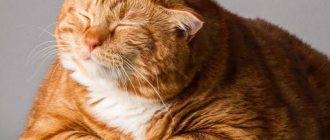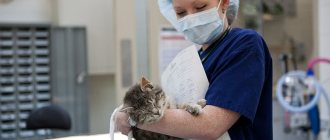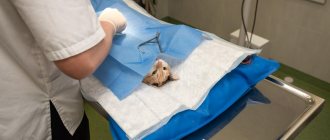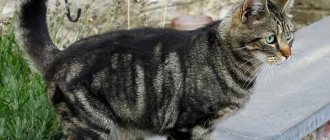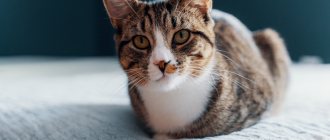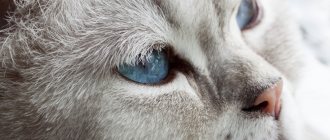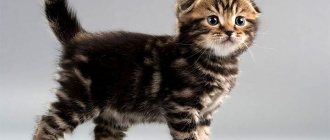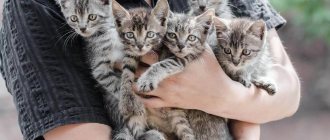For owners of purebred Scots, spaying or neutering their animals is always a difficult choice. For humane reasons, they do not want to inflict pain on their pet; they understand that many years of torture of not satisfying natural needs can affect the physical health of the pet and shorten its life. This is especially true for the castration of the Scottish Fold cat, Scottish Fold, Highland Fold, which have a genetic predisposition to serious diseases of the musculoskeletal system, mating within the breed, which is prohibited.
Veterinary medicine, castration and sterilization technologies have become more gentle and do not harm animals. They, especially cats, return to normal quite quickly after undergoing surgery.
The need for the procedure is also beneficial to the owners themselves:
- Brings relief from the unpleasant odor of urine, which the cat uses to mark its territory during the mating season.
- Saves from periodic, annoying screams and howls of a cat during heat.
Reasons for castration and minimum age
There are the following reasons why a kitten should be neutered:
- A cat that has reached sexual maturity will begin to demand a cat several times a year. In this case, the animal will meow loudly and may show aggression.
- A cat that is not spayed on time will mark its territory to avoid other cats, even if it is the only animal in the house. The tags have a strong, unpleasant odor and are difficult to remove from clothing, shoes and upholstered furniture. They can eat into carpets and floors.
A Scottish Fold kitten is ready for sterilization at 10 months. Before surgery, it is important to take your pet to a veterinarian so that he can assess how quickly the animal is developing and whether it is ready for sterilization.
How is the operation performed?
In general, castration of cats is a simple procedure, but it is performed under general anesthesia. Thanks to this, the animal does not experience pain both during surgery and later, since the analgesic effect after anesthesia lasts for 10-12 hours, and after this period the tissues begin to tighten and the remaining wounds do not cause discomfort. After castration, Scottish Fold cats are returned to their owners on the same day. Typically the whole process goes like this :
- preparation for surgery - administration of a sedative and relaxant;
- general anesthesia;
- preparation of the surgical site;
- direct removal of the testicles;
- antiseptic treatment;
- administration of antibiotics;
- administration of hemostatic agents;
- withdrawal from anesthesia;
- handing over the animal to the owners with all recommendations for care in the first days.
During the operation, incisions are made on the skin of the scrotum in 2 places and, by applying ligatures (silk clamps) to the spermatic cords, the testicles are removed. Stitches are not always required after surgery.
Castration of Scottish Fold cats can take place a little differently. If you have a cat in the house, you can perform a vasectomy on the cat. During such an intervention, the vas deferens are ligated, rather than the testicles are removed.
In this state, the animal cannot have offspring, but does not lose the ability to mate and protects its territory from encroachment by other cats.
It is not uncommon for breeders who keep cats to resort to such an operation, and the cat is invited for mating. In this case, a sterile male kept in the house fully brings the cats out of estrus, and there is no risk of producing unwanted offspring.
© shutterstock
General nuances
The most popular methods of castration are vasectomy and surgery. In the first case, the veterinarian will tighten the animal's vas deferens. As a result, it will be sterile, but will still be able to leave marks. In the second case, the pet's testicles will be removed. This will result in him never asking for the cat or marking his territory again.
It is worth considering one more nuance before taking your pet for castration - the animal must be sterilized before its first mating occurs. If it was already there, sex hormones will not stop being produced even after the operation. In this case, the cat will still demand the cat.
Postoperative care
After the operation in the clinic, the Scottish cat is given to the owner, who is under anesthesia. To provide postoperative care you must:
- transport the animal in a comfortable carrier;
- do not transport an operated cat on public transport, where it can easily pick up an infection;
- at home, allow the pet to freely recover from anesthesia; its duration depends on the drug administered and the cat’s body;
- the cat is placed on the floor, on a warm bedding, which must be changed in time if the cat pees itself;
- If, during the operation, external stitches were placed on the cat’s wounds, then a blanket is put on so that the cat does not reach them with her tongue;
- After the operation, the Scottish woman is not given food. Just put a bowl of water next to it;
- for postoperative constipation, the cat is given a laxative, on the advice of a veterinarian;
- Many people do prescribed intramuscular injections with antibiotics themselves or take their pet to the clinic;
- Wounds are treated with antiseptics twice a day;
- The blanket is removed only after the wounds have completely healed.
Cat food (after surgery)
It is necessary to feed a castrated cat after surgery taking into account his new physiological state, which changes dramatically. He loses interest in cats, and an increased desire for food appears, which is promptly regulated:
- On the first day after the operation, the animal is not fed; it may vomit from the anesthesia; water is placed nearby.
- They think over a diet for natural feeding with an emphasis on protein, fermented milk, ground foods and vegetables.
- With ready-made food, first they give wet food, premium class, designed for neutered cats.
- They feed cats in small portions, do not leave food in bowls, dose the food, and protect the cat from obesity.
- If the kitten is overweight, fasting days are arranged for him.
Cat food (after surgery)
The sterilization operation is difficult for a Scottish cat to tolerate, especially in the first days, until the suture has healed. Subsequently, the cat’s nutrition and behavior will be affected by hormonal imbalances in the body, increased appetite will appear, and metabolism will deteriorate. The owner must follow the rules:
- On the first day after surgery, while the anesthesia is in effect, the cat is not given food. Make sure she drinks water, otherwise dehydration may occur.
- After the operation, to prevent the stitches from coming apart, the castrated cat is fed light pureed food, preventing constipation from occurring.
- Meals should be fractional, in small portions 5-6 times a day, gradually increasing the daily intake to 150 grams.
- A properly formulated diet should contain -35% protein, 35% carbohydrates and 30% fat.
- After the stitches have healed, you can switch to ready-made super-premium food, specially produced for sterilized cats.
- It is necessary to regularly monitor the weight of the Scottish woman; if she deviates from the norm, she is put on a diet.
Features of castration at different ages
If the operation is performed before 10 months, complications may arise that can cause diseases: bladder and kidney diseases. The reason is that a kitten’s urethra is fully formed only by 10 months. Due to early sterilization, it will not have time to develop. As a result, the consequences of castration will include urethral obstruction.
It is also worth considering that early castration has a bad effect on the development of a cat. It will be smaller in size than its counterparts who did not undergo surgery. In the case of the Scottish breed, it is important to be careful because spaying too early can distort the animal's proportions and make its head disproportionately small.
You should not castrate cats older than 3 years, because at this age the risk of complications is higher. Internal bleeding may begin. In addition, the metabolism of adult animals is slower than that of kittens, and after surgery, the metabolic rate will decrease even more and lead to obesity.
Kittens at 10-12 months can be operated on under local anesthesia. An adult animal will need a general one, and this is harmful to the pet’s health.
Preparing the animal
Castration can be carried out only after examining the pet. Blood and urine tests must be taken from your Scottish Fold before surgery. It is also necessary to do an x-ray and ultrasound of the abdominal organs. Elderly animals should be shown to a veterinarian-cardiologist before castration to rule out heart pathologies.
Contraindications for surgery:
- estrus - 10 days must pass after its end;
- exacerbation of chronic diseases;
- lack of necessary vaccinations;
- signs of an infectious disease;
- presence of parasitic infestations.
8 hours before castration, the Scottish cat stops feeding, 3 hours before the intervention - water. It is advisable to perform the operation in the morning so that the owner has the opportunity to provide good care for the cat during the day.
Attention! A day or two before castration, you should not give your cat any medications without the permission of a veterinarian. Some drugs can affect blood clotting, leading to significant blood loss during surgery.
General facts
Castration is considered not such a simple operation as many assume. This is not just the removal of the testes: during the operation, the glands of the genital organs are cut and the reproductive functions of the body are completely stopped. The procedure can be carried out using several methods:
- Standard excision. This technique is the most common and simple.
- Fertility with the help of medications. For this, an implant is sewn under the skin with the required amount of medication that suppresses the cat’s sexual desire. This is an expensive but safe procedure.
- Chemical sterilization, during which a mixture of drugs is injected directly into the testes. This compound destroys the glands. Their tissue is then replaced by muscle tissue. This procedure, which has not taken root in our country, is considered easy to use and cheap.
- Castration under the influence of radiation. The organ is placed under gamma rays and treated. Such manipulation requires quite expensive equipment. From a safety point of view, this is a simple intervention that does not require anesthesia.
It is clear that surgical penetration into the animal's body is not always necessary. However, it is excision with a scalpel that is popular in domestic veterinary practice. Most likely, this is due to the low cost of the method.
Special habits of the Scots
Scottish Fold
Description of the character of the Scottish Fold cat can be described by their characteristic habits:
- Interesting and even funny leisure habits. They sleep on their backs, which is not typical for cats in principle. This sleeping position is not observed in any other breed of cat.
- Observing something while standing on its hind legs if the object is high.
- To attract attention and receive its share of affection, it can purr and rub its muzzle against a person.
- Can't stand being held or being squeezed. The cat may show its displeasure.
- In pursuit of an object of interest to them, for example, when playing with a person, they run very fast and can climb onto a hill. They jump well, run and have well-developed muscles.
- Scottish cats are usually silent. They voice only in important situations, in their own opinion. If you come across a sociable individual, you need to understand that he will become too sociable. He will accompany with his comments every step of the owner and his own. Many people don't like this behavior. Therefore, it is worth taking a closer look at the animal’s character while still in the nursery.
How can you recognize the character and disposition of a kitten from childhood? All kittens, due to their age, are active and curious.
Any rustle in the apartment arouses their attention and interest. It’s difficult to see a small kitten doing nothing; they are constantly busy with something and find new things to do.
If there is no toy, it will be replaced by any object that comes into the animal’s field of vision. The toy can even be an object imagined in the kitten’s fantasy or a play partner.
But there are kids who prefer to sit on the sidelines and not participate in these races; they play with their brothers reluctantly and rarely. This behavior is considered normal for this breed. Such individuals are considered less active, cautious, and calm. Such kittens spend time alone, exploring the surrounding space in a measured manner. It has been noticed that such animals are more devoted to their owners.
The letter M on the forehead of a Scottish cat
Good nature and sociability
The Scottish Fold cat breed can be called a model of behavior. They are reserved, well-mannered, and are not inclined to impose their company on a person. But the breed has a pronounced good nature and good sociability. This applies to people and animals. They are not distinguished by vindictiveness, which is observed in other cat breeds. Conflict situations for fold-eared and straight-eared cats are a rare situation in which the cat showed protective measures in response to aggression towards him. If you offend a Scottish dog, he will prefer to hide rather than get into a fight. This is a last resort for them.
How to express your desires
Scots express their desire for something with a special purr, a voice that is characteristic only of this breed
They can rub their muzzle against a person, follow him, and try in every possible way to get attention. They exhibit this behavior in cases of hunger, the need to play, and other situations that they consider important.
Activity
The character of the Scottish Straight cat is phlegmatic. Their movements are measured and unhurried. They rarely run, especially in adulthood. If an adult cat is asked to run after a candy wrapper or a string with a piece of paper, the cat will express its bewilderment and surprise. The best pastime for them is to lie on their bed and take a nap.
Cleanliness
This breed is considered clean. They love to take care of themselves and maintain hygiene. They can spend hours licking their fur. Some owners say that sometimes this ritual is similar to mania, and a person’s touching them is regarded as an encroachment on his freedom. This character trait also applies to the toilet. They should always have a clean tray, but it is not typical for the animal to miss it. Going to other places to relieve yourself is a crime and an extreme rarity for the Scots.
Choosing the right doctor is half the success
No matter how simple the castration procedure may seem, it must be carried out by a competent doctor. The Good Doctor veterinary clinic in Moscow has at its disposal everything you need for safe castration:
- We employ only qualified doctors;
- a full set of diagnostic equipment;
- possibility of observing the animal in a hospital.
If necessary, we can offer a doctor to visit your home in Moscow and the Moscow region. The cost of castration of a fold-eared cat depends on the state of his health. The price of castration or sterilization of a Scottish cat also depends on the method of performing the operation. Check prices when visiting the clinic: final and complete information can only be obtained after examining the animal.
Why is the procedure needed?
Sterilization and castration are carried out to normalize hormonal levels in those pets whose sexual needs cannot be satisfied naturally. There are two types of indications for surgery: medical and behavioral.
Behavioral factor
An indication for surgery may be the behavior of the animal:
- the cat constantly marks the territory, after which a pungent smell of urine remains;
- the pet is aggressive, rushes at people;
- During estrus, the cat suffers, screams loudly, and cannot find a place for itself.
If it is not possible to regularly satisfy your pet’s sexual needs, then it is better to undergo surgery. After it, the animal will stop suffering from dissatisfaction and will become much calmer and more affectionate. After castration, cats stop marking, and their urine loses its pungent odor.
Medical indications
Medical indications are primarily related to the fact that hormonal imbalances can lead to many diseases in pets:
- Oncological diseases. Cats may develop cancer of the mammary glands, ovaries and other genital organs. In cats, prostate cancer comes to the fore.
- Pathology of the genitourinary system. This category includes urethritis, prostatitis and other inflammatory and infectious diseases. In addition, it has been scientifically proven that this surgical intervention increases the life expectancy of the pet.
What vaccinations are given to kittens, cost
Small, helpless kittens receive the first antibodies that increase immunity along with the mother's cat's milk. After weaning, instead of colostrum, the baby needs additional protection of the body from viruses and bacteria. At the age of 8-10 weeks, vaccinations are required for Scottish kittens. Before the first vaccinations are carried out, the kitten is prepared and the body is prevented from worms.
Depending on the conditions of detention and lifestyle, the first vaccination for a Scot contains:
- a vaccine against herpesvirus, calicivirus, panleukopenia and rabies, even if the animal leads a permanent home lifestyle;
- They also vaccinate against viral leukemia and chlamydia if the kitten lives in a private house, in a country house and leaves the house where it has likely contact with other animals;
Vaccinations for fold-eared kittens, as well as straight-eared Scots, are performed in accordance with the following scheme:
- At 2 months, the full range of vaccinations with the exception of the rabies vaccine;
- At 3 months, revaccination is carried out with the same complex of drugs with the addition of rabies vaccine.
- Every year and beyond, as the child grows, the entire vaccination package is repeated, including the anti-rabies drug.
The cost of vaccination depends on the price of the drug and factors of the procedure in different regions of the country and consists of:
- from the cost of the most common complex of drugs: Purevax RCPCh + Rabizin + Nobivac Rabies;
- prices for issuing a veterinary passport;
- payment for the work of a veterinarian;
- payment for calling a doctor to your home.
Adults (what vaccinations are given to adults + cost)
Vaccinations for adult cats and Scottish cats have the following advantages:
- they support the immunity of animals to environmental living conditions.
- Vaccinated pets develop a persistent, throughout the year, resistance to serious diseases;
- The vaccinated animal is protected itself and the owner is guaranteed protection, for example, from rabies;
- The occurrence of some infectious processes in a mild form
- When walking in nature and interacting with other animals, the risk of your pet contracting an infection is reduced to a minimum.
Throughout life, the vaccination procedure is repeated annually, preferably in the same month of the year. They make sure that the animal is dewormed on time, is healthy, and that the cat is not pregnant or nursing cubs.
The basic composition and cost are similar to vaccination for kittens, depending on the region and other factors.
